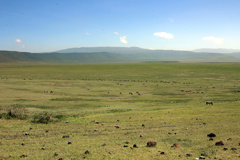The Ngorongoro crater sits at the Southeastern end of a much larger 8300km2 ecosystem

View looking Southeast from the forested
slopes of Ngorongoro
known as the Ngorongoro Conservation Area. The crater has an area of 265km2 and is 610m deep. There is a small soda Lake - Magadi - within it, but fortunately it is also stream fed and so there is fresh water available there and in other small lakes.
The Eastern sides of the crater highlands receive up to 1200mm of rain and are largely forested. To the West, rainfall is about 500mm and it is grassland and bush.
Much of the crater is grassland but there are also areas of forest and swamps which provide a wide variety of habitats and photo opportunities. Some of the huge fig trees in the Lerai forest are sacred to the Maasai and Datooga Peoples. The first Europeans visited the crater in 1892. It was farmed by two German brothers until the outbreak of WW1.

Ngorongoro crater from Western descent
road with Lake Magadi in the distance
Up to 20% of the grassland is burned in a controlled manner each year for conservation purposes, as it helps maintain the nutritious short grass which many of the ungulates prefer. Since around 1986 the numbers of wildebeeste and Thompson's gazelles have declined by about half while the numbers of buffalos have increased, probably due to earlier policies of not burning the grass.
The views from the Crater rim are breathtaking, and the game viewing will never be any easier. Most of East Africa's species are present, and the bonus for me was the black rhinoceros.

The dirt road across the Ngorongoro
highlands
However it must be said that the crater is so attractive to so many people that one of the commonest species within it is the Toyota Landcruiser. To those wanting to feel 'out there' in the wilds I would say don't visit. I found it to be very like driving round a Safari Park back home in the UK with the ever present noise of engines and people talking and laughing, especially around the lions or rhinos.
But, if it's your only chance in a lifetime to see a rhino or hippo, or buffalo or lion, then go, as the odds of seeing all of them are stacked in your favour.
Photographically it's great. Uninterrupted shots of habituated animals, so you can get pretty good closeups of most of them without a massive telephoto lens. And with an eye for compostition you can make it appear that there was not a single other person in the crater.
We experienced quite severe heat haze which made some of the long distance shots unuseable. It was OK first thing but as the day warmed up it got steadily worse.

The crater contains an estimated 30000 game
animals, but don't expect to see giraffes or
impalas
In the area to the West of the crater there are frequent Maasai villages and many herds of cattle and goats in the lush and beautiful Highlands. As you follow the road West through the Conservation Area to the Serengeti there are increasing amounts of zebras and giraffes to be seen between the herds of domestic livestock, and finally the highlands drop down in to the vast Serengeti plain.
On the whole - you have to go or you will probably kick yourself forever.
Watch the Ngorongoro video.